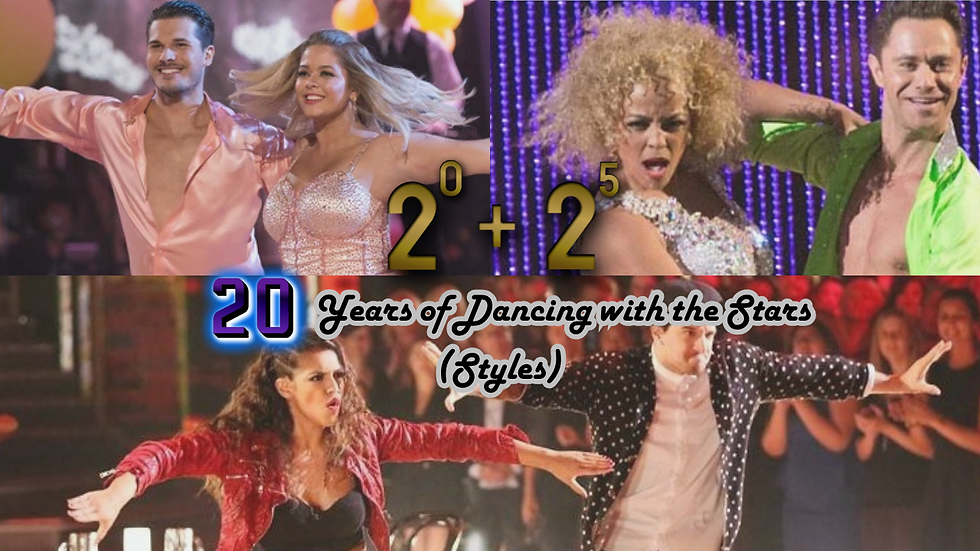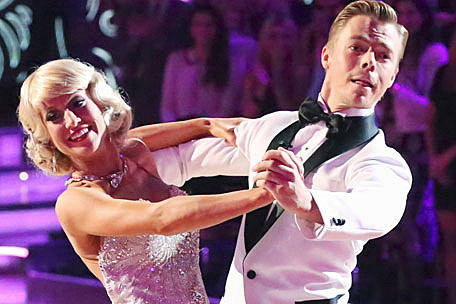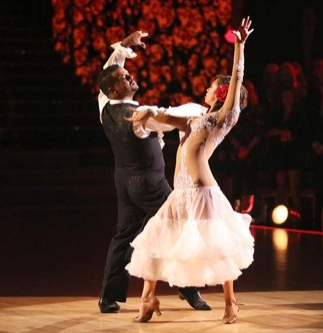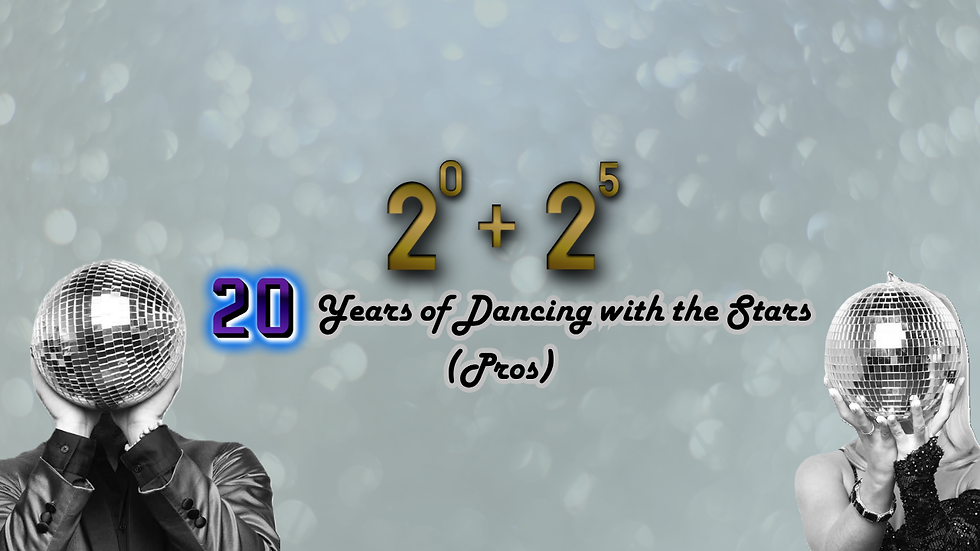2^0 + 2^5 (20 Years of Styles)
- Jordan
- Jul 7
- 6 min read
Updated: Jul 18

With the stars aligned and the pros in check, it's time to bring out some style...make that multiple styles!
In Dancing with the Stars, couples perform different styles of ballroom dance. There are 10 styles in total that couples are surrounded by, and they're divided into two categories: Ballroom and Latin. Each category consists of five styles.
The Ballroom category is made up of the Waltz, Tango, Viennese waltz, Foxtrot, and Quickstep while the Latin category is made up of the Cha-cha-cha, Samba, Rumba, Paso doble, and Jive. Let's learn more about each style, shall we? Here are brief definitions of each dance within the lexicon of basic ballroom dance.
Ballroom
Waltz - A graceful dance with turns done at a slow rate. An emphasis on having the body elevate up and down (or "rise and fall") is placed upon the Waltz. While the waltz was done throughout the 20-year time span, its use significantly decreased seemingly in favor for the similarly-styled Viennese waltz.
Tango - A passionate dance where couples perform with force and sharp head movements.
Viennese waltz - Akeen to the waltz though not exactly alike, the Viennese waltz has couples turn at a faster tempo. While the Viennese waltz has been performed since the first season, individual couple performances were not accustomed as part of the rotating styles until season 5.
Foxtrot - A dance encompassing a strength of eloquence through the use of flowy movements.
Quickstep - A dance where couples trot and hop across the floor at a very fast speed. Unlike the other ballroom-styled dances, quickstep requires couples to remain attached in a framed position for essentially the whole performance. The reasoning behind this centers around the other Ballroom styles being included under the two principal systems ballroom dance is associated with, International and American, while Quickstep is only included in the former. International requires couples to remain in closed framed positions during the dances while American allows them to break hold of their positions completely as they perform if they desire. Despite this, many of the performances have had couples break position because...it's TV.

Latin
Cha-cha-cha - A dance with precise, yet playful, steps.
Samba - A dance with bouncy movements and a festive flair. Among the Latin styles, the Samba has been noted as a highly difficult dance to technically execute within the show and in ballroom dance in general.
Rumba - A steamy dance done fluidly through great use of the hips. Make sure to wear shoes!
Paso doble - A powerful dance with stomping movements often regarded to evoke an essence similar to that of a bullfight. A use of a cape has sometimes been incorporated into couple's routines on the show.
Jive - A high-energy dance with excessive use of kicks done at fast speeds.

Other Styles
Over the 20-year timespan, Dancing with the Stars has included other styles that aren't part of the given lineup. Some have been done experimentally while others have been mainstays that tend to be included in the typical rotation of styles a couple might be tasked to do.
Afro-jazz - A variation of jazz (see "Jazz") highlighting African movements.
Argentine tango - A variation of tango with great emphasis on lifts. Argentine tango is one of the styles outside of the typical set heavily used in rotation.
Bhangra - A folk dance with springy movements done very energetically.
Bolero - A dance where movements switch from slow to quick through the use of a paused hold on parts of the rhythmic structure.
Bollywood - A wide ranged dance (from movements closer to the body to movements extending the body) decorated with intricate hand gestures.
Broadway - A precise theatrical dance used to progress a story. Since performances on Dancing with the Stars aren't done in arcs and are rather separate entities, there isn't really a progression present. A story is still nonetheless present since dancing in general incorporates stories to enhance its value.
Burlesque - A boastful dance with provocative movements done in a combined lustful and cheeky manner.
Charleston - A dance hubbed under swing (see "Swing") that contains a frequent use of leg twists. Though not as frequent of a style performed on the show's first 20 years, it does make quite a few appearances throughout.
Contemporary - A freeform dance that heavily draws from emotion. It made its first appearance in an all-stars season (15) when couples had to perform dance styles outside the usual lineup, but it was quickly adopted as a frequent style performed on the show after.
Disco - A flashy dance with an extroverted mix of partner work (including lifts) and side-by-side choreography.
Flamenco - A dance with stiff positions and use of foot taps.
Hip Hop - A product of the culture, Hip Hop dance comes with great use of shoulder movements used to control the mood of the performance (allowing for dancers to switch back and forth from a sleeker way of moving to a tougher way of moving throughout the performance).
Hustle - A dance hubbed under disco (see "Disco") making use of sharp steps that boost the speed of the dancers when performed.
Jazz - A clear-cut dance with portions of side-by-side choreography that's frequently used as a possible style amidst the likings of the Ballroom and Latin styles. Though it's called "Jazz," it doesn't necessarily need to be performed to jazz music.
Jitterbug - A dance hubbed under swing (see "Swing") that's more controlled in nature.
Lambada - A dance with use of controlled stops and steamy hip-intensive grinds typically done with arched legs.
Lindy Hop - A dance hubbed under swing (see "Swing") highly characterized by a "swingout" (a move where partners go from a closed position to an open position through airy footwork).
Mambo - A sensual dance with fast movements under a simple rhythmic count. Though mambo has been seen throughout the 20-year timespan, it was more frequently used in earlier seasons as early as season 3 (which peculiarly happened to be the same season Jesse DeSoto, a pro with expertise in mambo, was brought in).
Rock and roll - A carefree dance with liberating motions.
Salsa - A lighthearted dance with quick movements and quick spins. Salsa is one of the styles outside of the typical set heavily used in rotation.
Swing - An energetic dance with daring lifts and fast movements.
Two-step - A dance with use of quick and slow steps mixed in with counterclockwise rotation.
West Coast Swing - A highly elastic swing dance where improvisation is greatly used. The style was seemingly brought in to coincide with Lacey Schwimmer, a dancer with expertise in West Coast Swing, when she was brought in as a pro.
Other styles can be mixed in throughout the season or done on its own special week (such as a week on season 19 when celebrities had to perform a style outside Ballroom and Latin with a new pro)
Freestyle
Now, with all the styles out there, there's one that's oh so much desired by celebrities and pros alike on Dancing with the Stars that hasn't been talked about in this entry until this very moment: Freestyle! Based off the "Showdance" in the competitive ballroom world, freestyle allows dancers to...well...do whatever they want! It's a dance that lets the partnerships take control of mixing styles to benefit their strengths, and it's an overall fun blast to watch as a viewer because you don't know what the couples will pull out of their bag of tricks to showcase to you on the ballroom floor.
Freestyles come in many different flavors from large productions with arrays of back-up dancers to intimate pieces solely involving the celebrity and their pro
That was A LOT of styles to go through, and we're glad we went through in telling you them in this entry, but we're gonna move forward to another element of Dancing with the Stars that's grown vastly throughout its first 20 years to keep the dance train going. From marathons to dance-offs and relays to team dances, special dance formats are what's next up in this series. Catch the next entry to learn more about them. See you then!

















Comments